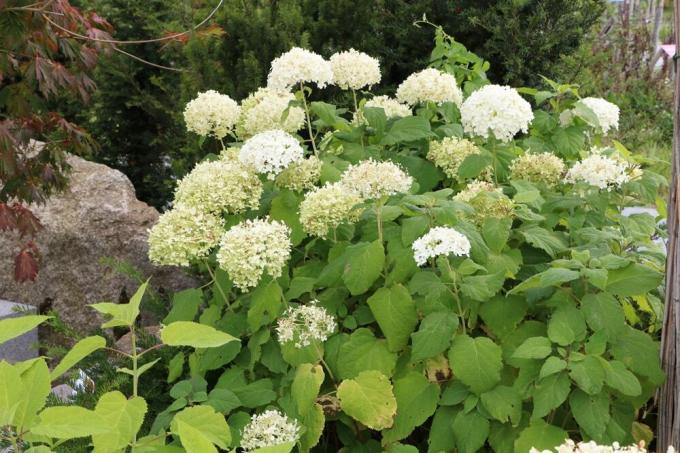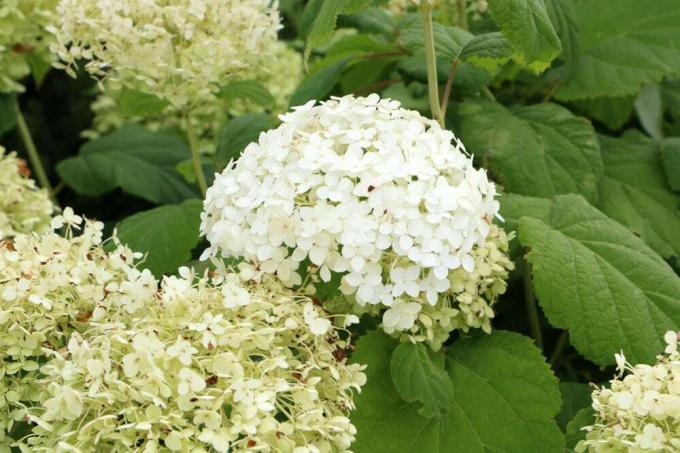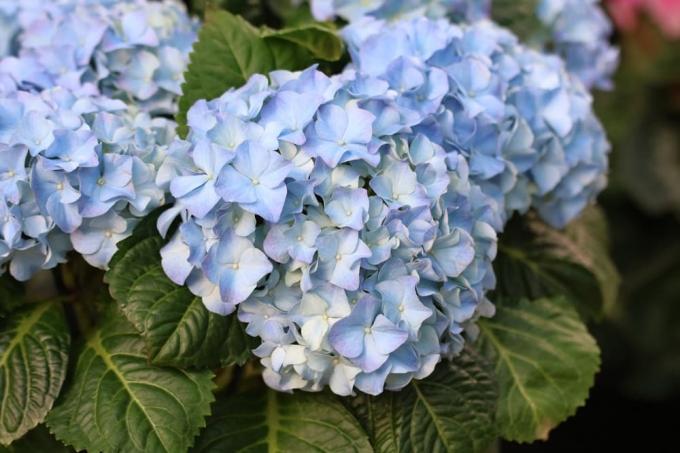

Table of contents
- Location
- Neighbors
- soil / substrate
- planting
- support
- Fertilize
- Pour
- repot
- Cut
- Slight pruning
- hibernate
- multiply
- diseases and pests
- care mistakes
The snowball hydrangea is a real feast for the eyes in the home garden and is very popular. Rightly so, because the hydrangea Annabelle blooms from the end of June to September and decorates the garden with its large, white flowers. However, their flowering splendor only shows up if they are cared for professionally. Because both the optimal location and the care measures are essential for the formation of flowers.
Location
The snowball hydrangea is also known as forest hydrangea because it grows in the open air in sparse forest areas. If the snap ball hydrangea is grown in the home garden, a location should be sought for it that is as partially shaded as possible. Because both too shady and too sunny a location are not good for the decorative plant Good: Too much sun shortens the flowering period and can cause sunburn on the existing flowers care for. If, on the other hand, the snowball hydrangea is too shady, the formation of flowers will be delayed. A semi-shady spot with sun in the morning and in the evening is therefore ideal for them. When choosing a location, the following should also be considered:
- protected from the wind as much as possible
- leave sufficient planting distance
- as a hedge: about 35-85 cm apart
- in the group: 80-150 cm distance
Neighbors
Snowball hydrangeas do particularly well in sparsely planted areas under trees. Here the hydrangea not only comes into its own, but can also benefit from the tree: Because this one not only provides shade for the decorative plant, but also protects it from heavy rain by absorbing the precipitation softens. The natural rain protection is an advantage for the hydrangea, because heavy rain causes the flowers to become increasingly swollen, which could cause the flower stalks to bend over. However, the hydrangea does not necessarily have to be planted next to a tree. In a rain-protected spot, it also harmonizes very well with large-leaved ornamental perennials and various ferns:
- aconite
- globe thistle
- hosts
- lupis
- daylilies
- boxwood
- japanese dwarf spars
- dark-leaved fan maples
soil / substrate

Hydrangea Annabelle thrives best in soil that has the same characteristics as a typical forest soil. This contains about 5 to 10 percent humus and around 50 percent mineral soil particles, which are formed by the weathering of rock. The snowball hydrangea benefits in particular from the humic substances, because these ensure that the air and water in the soil are permeated. This promotes plant growth because it binds moisture in the soil and makes more nutrients available. The snowball hydrangea also thrives best when the soil meets the following requirements:
- humus rich and loose
- sufficiently moist
- pH neutral to acidic
- a pH value of 5.5-6.0 is optimal
- as low a lime content as possible
If the snowball hydrangea is cultivated in a pot, it should preferably be placed in a mixture of rhododendron soil with humus-rich soil. Alternatively, bog bed soil is also suitable.
planting
The hydrangea Annabelle is considered to be completely hardy, which is why it does not necessarily have to be planted in spring. Although the planting season extends throughout the year, the best time to plant is still early spring. As a result, the practiced hobby gardener can already enjoy the decorative splendor of flowers in the first year. Before the snowball hydrangea is planted, it is advisable to first prepare the soil thoroughly and improve it if necessary. If necessary, sand or leaf humus, for example, can be worked into the soil. Then proceed as follows when planting:
- Dig a planting hole
- this should be about twice the size of the planter
- Soak the root ball in water for about 10 minutes
- as a result, the earth soaks up water and stores it
- Plant carefully
- cover with earth
- then water well
Tip:
If the snowball hydrangea is cultivated in the bucket, drainage should definitely be created in the bucket. For this purpose, gravel or grit is laid out on the bottom of the bucket so that the excess water can drain off.
support

The particularly large flowers of the hydrangea Annabelle look magnificent, but there is a risk that the plant will snap under the heavy blooms. If the inflorescences sink slightly towards the ground over time, this is generally not a problem for the shrub. However, if you want to make sure that the snowball hydrangea does not fall over, you should support it as soon as the flowers get significantly larger. The following tools are suitable for this:
- perennial support
- bamboo sticks
- grid
Fertilize
The snowball hydrangea's nutrient requirement is moderate, but the decorative plant also enjoys an occasional fertilizer release. Organic fertilizers such as mature compost, plant manure or horn shavings are particularly suitable for this. These also have the advantage that over time they break down in the soil and over-fertilization is therefore hardly possible. A hydrangea fertilizer with an emphasis on potash and magnesium is also suitable, but is usually a little higher in price. Alternatively, a fertilizer for azaleas or rhododendrons can also be used. When fertilizing snowball hydrangeas, the following should be observed:
- Fertilize with organic compound fertilizer from spring to July
- apply a hydrangea fertilizer every 4 weeks between April and October
- do not fertilize more often, otherwise the plant will form soft shoots
- these cannot carry the heavy inflorescences
- never use blue grain, because it contains too much nitrogen
- not to use garden compost, because this is usually very calcareous
If the snowball hydrangea is cultivated in a bucket, it usually has a higher nutrient requirement, which is why it has to be fertilized more often. A liquid hydrangea fertilizer is suitable for this, which is administered once a week in spring and summer.
Pour
The snowball hydrangea has a fairly high water requirement, as it needs around 10 liters of water per day. Accordingly, it should be watered regularly, with freshly planted hydrangeas in particular wanting to be kept moist in the first few weeks. The hydrangea Annabelle does not necessarily have to be watered with rainwater, because it also tolerates drinking water very well. The decorative seedling is best watered as follows:
- always keep moist
- Water when the soil surface is still slightly damp
- Water roots directly
- water in the morning and evening in summer
- Avoid waterlogging at all costs!
Tip:
If you water the snowball hydrangea with tap water, you should definitely pay attention to the degree of hardness of the water. If the degree of hardness is over 14° dH, it is advisable to decalcify the water before watering. For this purpose, the water is filled into a container and a bag filled with peat is hung in it. If the water is left overnight, it will be softer the following day.
repot
As soon as the snowball hydrangea outgrows its container and its roots no longer have enough space, it should be repotted. The diameter of the new container should be at least 5 centimeters larger than the previous one, so that there is enough space for the roots. The bottom of the container is first covered with pebbles or clay granules before the plant is repotted as follows:
- Fill the new container one-third full with soil
- Tilt the hydrangea and pull off the old container
- Carefully remove used soil
- Be careful not to damage the root ball
- if necessary, remove part of the root mass
- use a sharp cutting tool for this
- Place the hydrangea in the middle of the new container
- Fill the container with soil and press down lightly
- finally watering
- Soil should be moist but not wet
Tip:
Although the plant can be planted and repotted all year round, spring is the best time to do this work.
Cut
Hydrangea Annabelle is pruned either in winter or in mid-winter. in spring or in autumn. Because the plant forms its flowers on the one-year-old wood, which is why new growth can be expected from March. The choice of the right time also depends on the weather conditions, because the cut should definitely take place on a frost-free day. How far the snowball hydrangea is cut back is up to the taste of the hobby gardener. Although it can tolerate a radical pruning down to around 15 centimeters above the ground, it is not necessarily dependent on it. However, a radical pruning promotes new growth, as this gives the plant more power to do so. The pruning of the snowball hydrangea is as follows:
- Cut back to about 15 cm above the ground
- however, a pair of eyes should remain on the shoot
- as a result, the hydrangea sprout particularly vigorously
- and forms large inflorescences
- Remove thin and dead shoots
Tip:
Do not remove the withered inflorescences, as these serve as natural winter protection for the plant.
Slight pruning
If the snowball hydrangea is in a windy location that is not protected from the rain, a radical pruning is not advisable. Because the new shoots are usually not very stable, which can lead to the plant hanging its flower heads, especially after heavy rainfall. In such cases, it is better to cut back the snowball hydrangea only slightly. Although this has the disadvantage that the flowers do not grow quite as large, the branch structure is more stable and the plant does not snap off as easily.
hibernate
The snowball hydrangea is considered to be completely hardy and can easily withstand temperatures down to -25 degrees. However, it is advisable to protect freshly planted hydrangeas from frost in the first year. A burlap cover offers the young plants sufficient frustration protection when it is pulled over them. If the winter is particularly windy and there is little snow, it is advisable to provide additional protection for the roots of the snowball hydrangea. For example, a thick layer of straw, brushwood or leaves can be spread around the plants. When cultivating in a bucket, on the other hand, frost protection is essential, otherwise there is a risk that the planter will freeze completely. The following measures protect the plants in the winter months:
- Put a burlap sack over the plant
- Place the bucket on a wooden or styrofoam board
- place in a sheltered place
- alternatively bring the plant into the house
- Location should be as cool as possible
- Temperatures of 16-18 degrees are ideal
Tip:
The snowball hydrangea must never dry out, regardless of whether it is cultivated outdoors or in a bucket. It is therefore essential that it is always watered during the winter months.
multiply

The snowball hydrangea can be propagated both by cuttings and by sinkers. If you want to propagate your plant with cuttings, first choose a strong one and cut it back to around 15-20 centimeters. It is important that there are at least two eyes on the shoot. Once you have selected the right cutting, proceed as follows:
- cut off the lower end diagonally
- cut the top straight
- Stick the cutting halfway into potting soil
- Always keep soil moist
- put in a shady place
- after a short time the cuttings will already form roots
- and can be planted
Propagation by sinkers is best done in the summer months. First, a channel is dug into the ground with a spade. Then a shoot that is as little woody as possible is selected and lightly scored in two or three places. Now the sinker is pulled to the ground and covered with soil, whereby the end of the shoot should still be visible. In addition, the sinker can be weighed down with stones if necessary so that it does not ring back up. As soon as the shoot has formed its own root system, it is cut off from the mother plant and planted in its new location.
diseases and pests
One of the few diseases that could affect snowball hydrangea is powdery mildew. This is a stubborn fungal infection, which is favored by drought. If the plant is infected, the affected plant parts must be cut off immediately and disposed of in the residual waste. However, powdery mildew can be prevented by preferably watering the plants in the early morning hours and by keeping a sufficient distance from their neighbors. The snowball hydrangea is also often attacked by the following pests:
- aphids
- ants
- scale insects
- weevil
The aphids in particular like the snowball hydrangea and at the same time attract the annoying ants. The pests can be eliminated by setting up sticky traps with pheromones. In addition, the application of nettle manure as a remedy against aphids has proven itself. Instead of nettle manure, milk water is also suitable, which is mixed in the ratio of 1 liter of water to 0.5 liters of milk and then sprayed.
care mistakes
The snowball hydrangea is considered to be particularly robust against diseases, but any care mistakes become noticeable relatively quickly. For example, if the plant lets its leaves droop, this is usually a sign of a lack of water. In such cases, it should be watered immediately. If the leaves turn yellow, this is usually due to the pH value of the soil being too high, waterlogging or an iron deficiency. If the pH is too high, humus should be added to the soil.
 garden editorial
garden editorial I write about everything that interests me in my garden.
Learn more about potted plants

Spider Flower, Cleome hassleriana: Care Instructions
Spider flowers get their name from their spider-like appearance. Many hobby gardeners shy away from cultivating the beautiful exotic species. When it comes to maintenance, there are just a few things to keep in mind.

How do I care for a gentian tree? Lycianthes rantonnetii
A gentian tree can be a decorative enrichment both on the balcony and in the garden. For the culture, however, some criteria must be observed. This includes, among other things, the high nutrient content that is required for flowering.

Overwinter pampas grass | 16 tips for winterizing
Pampas grass is a popular ornamental plant in the garden or in tubs, which can be attractively integrated into a wide variety of garden ideas thanks to its decorative fronds. They are considered hardy, but need suitable winter protection in Central Europe due to possible moisture damage.

Leadwort, plumbago: care from A to Z
Leadwort (Plumbago) hides one of the most attractive potted plants of all. The magnificent shrub impresses above all with its blue flowers, which it produces from May to autumn, transforming terraces and balconies into a luminous oasis.

Hydrangeas, rhododendrons and hibiscus smoke | dangers of drugs
Anyone who has cultivated hydrangeas, rhododendrons or hibiscus in the front yard may be surprised that the beautiful flowers were cut off by unknown persons. Because especially among young people, there is a rumor that these flowers can be smoked and have the effect of marijuana. But this is dangerous information.

Peasant hydrangea, Hydrangea macrophylla - care and pruning
With its attractive, ball-shaped umbels of flowers in white, pink, purple, red or blue, the hydrangea is one of the most decorative garden plants. Here's what you need to know about the farmer's hydrangea so that it blooms and thrives lushly in your garden.
